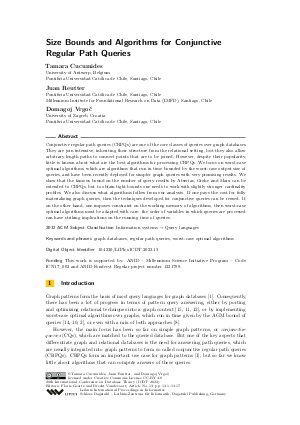Size Bounds and Algorithms for Conjunctive Regular Path Queries
Authors Tamara Cucumides, Juan Reutter, Domagoj Vrgoč
-
Part of:
Volume:
26th International Conference on Database Theory (ICDT 2023)
Part of: Series: Leibniz International Proceedings in Informatics (LIPIcs)
Part of: Conference: International Conference on Database Theory (ICDT) - License:
 Creative Commons Attribution 4.0 International license
Creative Commons Attribution 4.0 International license
- Publication Date: 2023-03-17
File

PDF
LIPIcs.ICDT.2023.13.pdf
- Filesize: 0.72 MB
- 17 pages
Document Identifiers
Subject Classification
ACM Subject Classification
- Information systems → Query languages
Keywords
- graph databases
- regular path queries
- worst-case optimal algorithms
Metrics
- Access Statistics
-
Total Accesses (updated on a weekly basis)
0Document
0Metadata
Abstract
Conjunctive regular path queries (CRPQs) are one of the core classes of queries over graph databases. They are join intensive, inheriting their structure from the relational setting, but they also allow arbitrary length paths to connect points that are to be joined. However, despite their popularity, little is known about what are the best algorithms for processing CRPQs. We focus on worst-case optimal algorithms, which are algorithms that run in time bounded by the worst-case output size of queries, and have been recently deployed for simpler graph queries with very promising results. We show that the famous bound on the number of query results by Atserias, Grohe and Marx can be extended to CRPQs, but to obtain tight bounds one needs to work with slightly stronger cardinality profiles. We also discuss what algorithms follow from our analysis. If one pays the cost for fully materializing graph queries, then the techniques developed for conjunctive queries can be reused. If, on the other hand, one imposes constraint on the working memory of algorithms, then worst-case optimal algorithms must be adapted with care: the order of variables in which queries are processed can have striking implications on the running time of queries.
Cite As Get BibTex
Tamara Cucumides, Juan Reutter, and Domagoj Vrgoč. Size Bounds and Algorithms for Conjunctive Regular Path Queries. In 26th International Conference on Database Theory (ICDT 2023). Leibniz International Proceedings in Informatics (LIPIcs), Volume 255, pp. 13:1-13:17, Schloss Dagstuhl – Leibniz-Zentrum für Informatik (2023)
https://doi.org/10.4230/LIPIcs.ICDT.2023.13
BibTex
@InProceedings{cucumides_et_al:LIPIcs.ICDT.2023.13,
author = {Cucumides, Tamara and Reutter, Juan and Vrgo\v{c}, Domagoj},
title = {{Size Bounds and Algorithms for Conjunctive Regular Path Queries}},
booktitle = {26th International Conference on Database Theory (ICDT 2023)},
pages = {13:1--13:17},
series = {Leibniz International Proceedings in Informatics (LIPIcs)},
ISBN = {978-3-95977-270-9},
ISSN = {1868-8969},
year = {2023},
volume = {255},
editor = {Geerts, Floris and Vandevoort, Brecht},
publisher = {Schloss Dagstuhl -- Leibniz-Zentrum f{\"u}r Informatik},
address = {Dagstuhl, Germany},
URL = {https://drops.dagstuhl.de/entities/document/10.4230/LIPIcs.ICDT.2023.13},
URN = {urn:nbn:de:0030-drops-177552},
doi = {10.4230/LIPIcs.ICDT.2023.13},
annote = {Keywords: graph databases, regular path queries, worst-case optimal algorithms}
}
Author Details
- University of Antwerp, Belgium
- Pontificia Universidad Católica de Chile, Santiago, Chile
- Pontificia Universidad Católica de Chile, Santiago, Chile
- Millennium Institute for Foundational Research on Data (IMFD), Santiago, Chile
Funding
This work is supported by: ANID - Millennium Science Initiative Program - Code ICN17_002 and ANID Fondecyt Regular project number 1221799.
References
-
Renzo Angles, Marcelo Arenas, Pablo Barceló, Aidan Hogan, Juan L. Reutter, and Domagoj Vrgoc. Foundations of Modern Query Languages for Graph Databases. ACM Comput. Surv., 50(5):68:1-68:40, 2017.

-
Diego Arroyuelo, Aidan Hogan, Gonzalo Navarro, Juan L. Reutter, Javiel Rojas-Ledesma, and Adrián Soto. Worst-case optimal graph joins in almost no space. In Guoliang Li, Zhanhuai Li, Stratos Idreos, and Divesh Srivastava, editors, SIGMOD '21: International Conference on Management of Data, Virtual Event, China, June 20-25, 2021, pages 102-114. ACM, 2021.

- Diego Arroyuelo, Aidan Hogan, Gonzalo Navarro, and Javiel Rojas-Ledesma. Time-and space-efficient regular path queries on graphs. arXiv preprint, 2021. URL: http://arxiv.org/abs/2111.04556.
-
Albert Atserias, Martin Grohe, and Dániel Marx. Size bounds and query plans for relational joins. SIAM J. Comput., 42(4):1737-1767, 2013.

-
Pablo Barceló Baeza. Querying graph databases. In Proceedings of the 32nd ACM SIGMOD-SIGACT-SIGART Symposium on Principles of Database Systems, PODS 2013, New York, NY, USA - June 22-27, 2013, pages 175-188, 2013.

-
Angela Bonifati, Wim Martens, and Thomas Timm. An analytical study of large SPARQL query logs. VLDB J., 29(2-3):655-679, 2020.

-
Katrin Casel and Markus L. Schmid. Fine-grained complexity of regular path queries. In 24th International Conference on Database Theory, ICDT 2021, March 23-26, 2021, Nicosia, Cyprus, pages 19:1-19:20, 2021.

-
Michael J. Freitag, Maximilian Bandle, Tobias Schmidt, Alfons Kemper, and Thomas Neumann. Adopting worst-case optimal joins in relational database systems. Proc. VLDB Endow., 13(11):1891-1904, 2020.

-
Georg Gottlob, Stephanie Tien Lee, Gregory Valiant, and Paul Valiant. Size and treewidth bounds for conjunctive queries. J. ACM, 59(3):16:1-16:35, 2012.

-
Aidan Hogan, Cristian Riveros, Carlos Rojas, and Adrián Soto. A worst-case optimal join algorithm for SPARQL. In The Semantic Web - ISWC 2019 - 18th International Semantic Web Conference, Auckland, New Zealand, October 26-30, 2019, Proceedings, Part I, pages 258-275, 2019.

-
Thomas Neumann and Gerhard Weikum. Rdf-3x: a risc-style engine for rdf. Proceedings of the VLDB Endowment, 1(1):647-659, 2008.

-
Thomas Neumann and Gerhard Weikum. The rdf-3x engine for scalable management of rdf data. The VLDB Journal, 19(1):91-113, 2010.

-
Hung Q. Ngo, Christopher Ré, and Atri Rudra. Skew strikes back: new developments in the theory of join algorithms. SIGMOD Rec., 42(4):5-16, 2013.

-
Dung Nguyen, Molham Aref, Martin Bravenboer, George Kollias, Hung Q Ngo, Christopher Ré, and Atri Rudra. Join processing for graph patterns: An old dog with new tricks. In Proceedings of the GRADES'15, pages 1-8. ACM, 2015.

- Jena Team. TDB Documentation, 2021. URL: https://jena.apache.org/documentation/tdb/.
-
Todd L. Veldhuizen. Triejoin: A simple, worst-case optimal join algorithm. In Nicole Schweikardt, Vassilis Christophides, and Vincent Leroy, editors, Proc. 17th International Conference on Database Theory (ICDT), Athens, Greece, March 24-28, 2014, pages 96-106. OpenProceedings.org, 2014.

-
Virginia Vassilevska Williams and R Ryan Williams. Subcubic equivalences between path, matrix, and triangle problems. Journal of the ACM (JACM), 65(5):1-38, 2018.

-
Peter T. Wood. Query languages for graph databases. SIGMOD Rec., 41(1):50-60, 2012.

